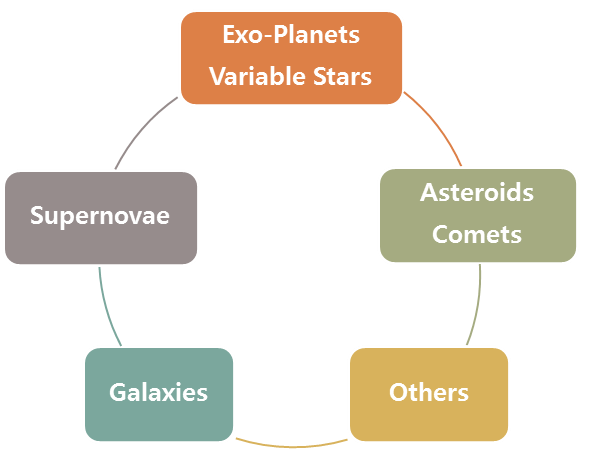Introduction
Searching for extrasolar planets is one of the primary research themes that is conducted with most modern astronomical instruments. In particular, the detection of earth-like planets in the habitable zone is regarded as the primary milestone of disclosing the existence of extra-terrestrial life. KASI started the KMTNet project in January 2009, which is to install 2.0 m class wide-field optical telescopes and mosaic CCD cameras at three southern observatories. These telescopes and cameras were planned to use for 24-hour continuous monitoring of the Galactic bulge with a high cadence of about 10 minutes. This system configuration and observation strategy were proposed by the microlensing community as a next generation microlensing experiment, and the community predicted that the KMTNet-like system could detect a few hundred of extrasolar planets per year, including free-floating planets (Henderson, C. B. et al. 2014, ApJ, 794, 52).
The KMTNet aims primarily to discover extrasolar planets based on the analyses of gravitational microlensing phenomena, especially the detection of earth-mass planets in the habitable zone. In addition, we anticipated a variety of scientific cases that can take advantage of the wide-field observation system. The parameter A*Ω, called etendue, is in general use to measure the power of a wide-field observation system, where A is the effective light-gathering area of the telescope and Ω is the field of view with a single exposure of the camera. The etendue of the KMTNet is about 6.0 m2 deg2, which is comparable with those of recent world-leading survey telescopes, for example, 5.2 m2 deg2 for the SkyMapper 1.35 m telescope, 6.8 m2 deg2 for the VISTA 4.0 m telescope, and 13 m2 deg2 for the Pan-STARRS 1.8 m telescope.
Therefore, the KMTNet system has a very competitive power for wide-field photometric survey sciences that study supernovae, asteroids and external galaxies, for instance. Because the observation period of the Galactic bulge focuses on the primary science on extrasolar planets, the other science programs are performed in the season when the Galactic bulge is not observable.
Links
Korea Astronomy & Space Science Institute
SSO in Australia (Live, Forecast)
SAAO in South Africa (Live, Forecast)
CTIO in Chile (Live, Forecast)
KMTNet Microlensing Science (Member Only)
KMTNet Supernova Project
Extrasolar Planets Encyclopaedia
Planetary Habitability Laboratory
OGLE EWS
MOA (Privoius Years)
Searching for extrasolar planets is one of the primary research themes that is conducted with most modern astronomical instruments. In particular, the detection of earth-like planets in the habitable zone is regarded as the primary milestone of disclosing the existence of extra-terrestrial life. KASI started the KMTNet project in January 2009, which is to install 2.0 m class wide-field optical telescopes and mosaic CCD cameras at three southern observatories. These telescopes and cameras were planned to use for 24-hour continuous monitoring of the Galactic bulge with a high cadence of about 10 minutes. This system configuration and observation strategy were proposed by the microlensing community as a next generation microlensing experiment, and the community predicted that the KMTNet-like system could detect a few hundred of extrasolar planets per year, including free-floating planets (Henderson, C. B. et al. 2014, ApJ, 794, 52).

The KMTNet aims primarily to discover extrasolar planets based on the analyses of gravitational microlensing phenomena, especially the detection of earth-mass planets in the habitable zone. In addition, we anticipated a variety of scientific cases that can take advantage of the wide-field observation system. The parameter A*Ω, called etendue, is in general use to measure the power of a wide-field observation system, where A is the effective light-gathering area of the telescope and Ω is the field of view with a single exposure of the camera. The etendue of the KMTNet is about 6.0 m2 deg2, which is comparable with those of recent world-leading survey telescopes, for example, 5.2 m2 deg2 for the SkyMapper 1.35 m telescope, 6.8 m2 deg2 for the VISTA 4.0 m telescope, and 13 m2 deg2 for the Pan-STARRS 1.8 m telescope.
Therefore, the KMTNet system has a very competitive power for wide-field photometric survey sciences that study supernovae, asteroids and external galaxies, for instance. Because the observation period of the Galactic bulge focuses on the primary science on extrasolar planets, the other science programs are performed in the season when the Galactic bulge is not observable.
Animation of two extrasolar planets orbiting around the eclipsing binary
(Discovered by Lee, J. W. et al. 2009, AJ, 137, 3181)
Links
Korea Astronomy & Space Science Institute
SSO in Australia (Live, Forecast)
SAAO in South Africa (Live, Forecast)
CTIO in Chile (Live, Forecast)
KMTNet Microlensing Science (Member Only)
KMTNet Supernova Project
Extrasolar Planets Encyclopaedia
Planetary Habitability Laboratory
OGLE EWS
MOA (Privoius Years)
 |
776, Daedeokdae-ro, Yuseong-gu, Daejeon, Republic of Korea (34055)
Copyright ⓒ Korea Microlensing Telescope Network All Rights Reserved |
 |
 KOREAN
KOREAN